How to Measure SEO Success – The Ultimate Metrics Guide
Ranking on top of the result pages or attracting a high volume of traffic to your site doesn’t necessarily guarantee a high return on investment.
Don’t get me wrong. All these metrics are excellent indicators of an effective SEO strategy. But SEO is like every other essential part of digital marketing; it should impact the bottom line.
SEO is a long-term strategy. It can drive incremental traffic to your site, boost conversions, and snowball your overall marketing ROI if properly executed.
So, how do you decipher if you’re on the right track? What metrics do you measure from the outset of your campaign to ensure that your SEO efforts are hitting the mark?
The good news is there are several methods (and tools) to help you measure the results that drive conversions and not just clicks.
In this article, I highlighted the significant metrics in SEO and how to track them.
Measuring SEO success is crucial, but getting it right takes expertise. Partner with us to track the right metrics and ensure your strategy delivers results. Request a tailored proposal today and start seeing success with our proven approach.

The pillars of SEO measurement
The first step to tracking your SEO success is defining what ‘success’ means to you.
The truth is, there’s no shortage of metrics to track in SEO. Setting your end goal upfront helps track what’s working and what’s not.
For example, if you’re a small business owner, success could mean increasing brand visibility and building a loyal list of customers.
For enterprise brands, it’s a different scenario. They would focus on scaling and expanding business offerings and in this case, the quality of leads will be a success factor.
Conclusively, your end goal should align with your overall business objectives. This approach helps you stay on course and achieve uniformity with your other marketing campaigns.
Having worked with several businesses for almost two decades, including small businesses and Fortune 1000, here are the metrics to start with:
1. Organic Traffic Metrics:
Organic traffic metrics measure the number of searchers visiting your site from search engines. High organic traffic implies that more people are visiting your site online through branded or unbranded keywords.
According to this research by Backlinko, the top five Google search results get 67.6% of all clicks. So, if you’re ranking on the first page without getting clicks, it’s a red flag.
2. Keyword rankings:
Keyword rankings measure the position of your website on search results for specific queries.
It’s one of the most vital metrics to track because it helps you decipher how your website gains visibility on the SERPs.
3. Conversion metrics:
How do you know if your SEO campaign generates revenue for your business? This is where conversion metrics come in. It tracks the rate at which visitors take important action on your site, such as making a purchase, signing up for a newsletter, or subscribing to a service.
4. Backlink analysis
Link building is another vital metric to track in SEO. This is because it has a direct impact on your search rankings. Google also pointed out that they use the quality of inbound links to a site to determine a website’s trustworthiness and credibility:

This means the more relevant and quality links to your site, the higher your chances of ranking on the SERPs.
Note: Not all backlinks are relevant, though. Keeping track of your backlink profile enables you to monitor the quality of websites linking to your site.
5. User engagement metrics
Lastly, user engagement metrics measure how users interact with your web content. This includes the total time spent on the page, their activities, page views, the total number of social shares, etc.
Tracking user engagement gives you deep insights into your customer journey and how to improve it.
Diving into organic traffic metrics
Evaluating your website traffic helps you know how your customers search for you online, the exact search queries they’re using, and how well you perform compared to your competitors.
There are several evaluations you can draw from tracking organic traffic:
Total organic session:
This measures the number of users that visit your page from organic searches. Each session can be a single-page view, for example, reading an article or multiple activities, such as completing a transaction.
New vs. returning visitors:
You can track and differentiate user sessions on your Google Analytics, including first-time and returning visitors. So whenever a user visits your web page for the first time, Google uses cookies to determine if the user is new, the time of visit, and location.
Geographical distribution of traffic:
Evaluating organic traffic also provides insights into the geographical regions of your web visitors. This metric tracks how many unique visitors you get from each region at any specific period.
Devices or browsers used:
Lastly, you’ll also get a breakdown of the type of devices your visitors are using when searching online.
How to track organic traffic
Google Analytics and Search Console are the two primary options to track organic traffic.
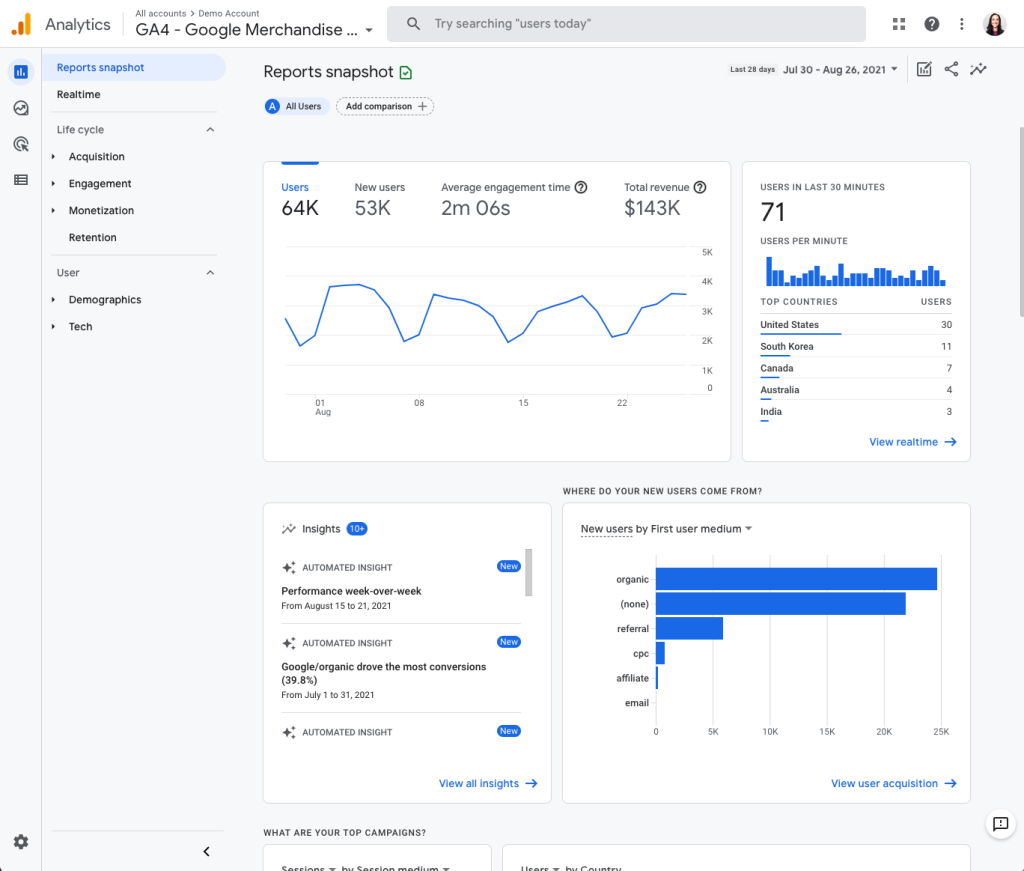
Both platforms are completely free. All you need to do is input your website link to access its performance analytics, including issues affecting your SEO. More about this later.
Another option is to use any third-party SEO tool, like SEMRush, Ahrefs, Moz, etc. These platforms provide deeper insights into your web performance, including organic traffic.
You’ll see where your traffic is coming from, the page pulling this traffic, and how you stack up against your competitors.
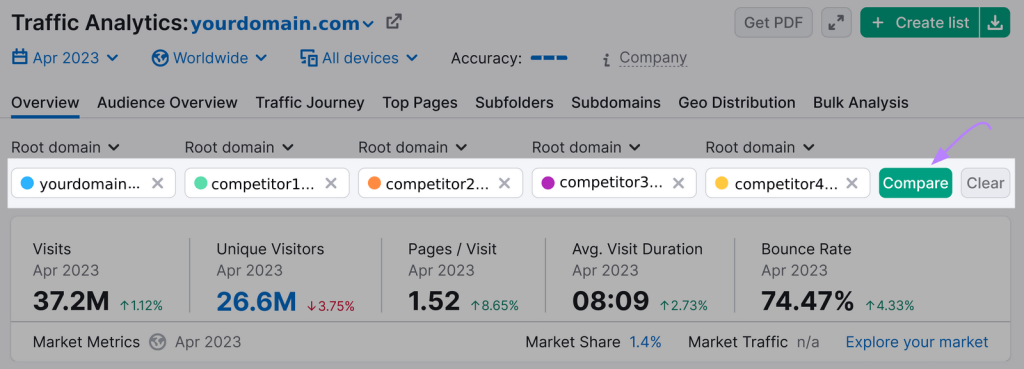
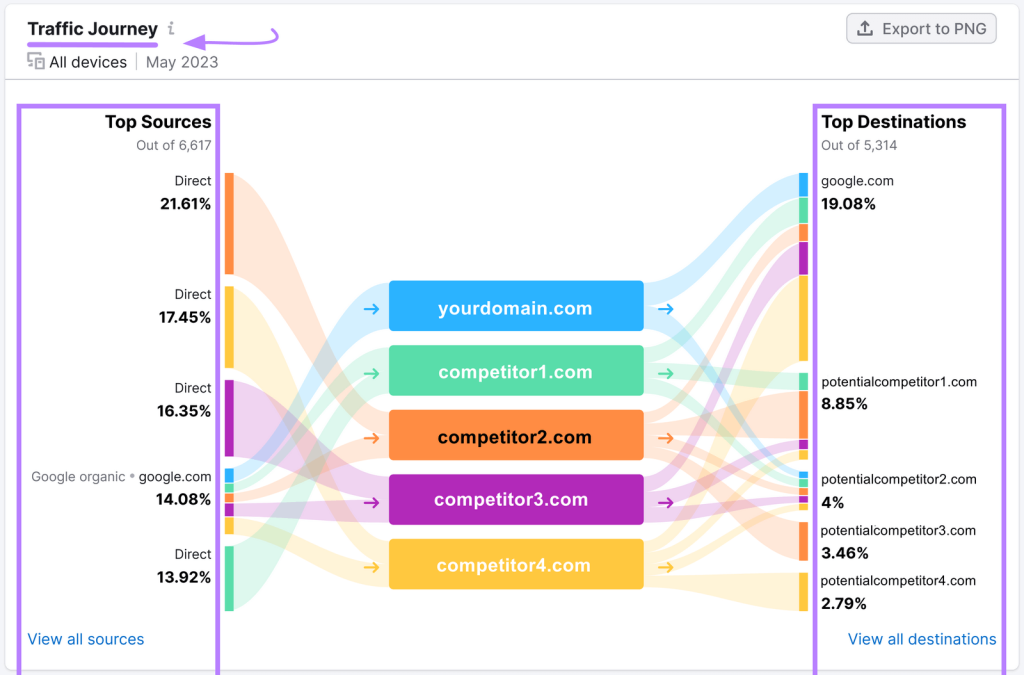
Understanding keyword ranking:
This research by Backlinko proves that the first five search results get over 67% of all clicks. And only 0.63% of the total web traffic on Google visits the second page. This means the higher your rankings on the SERPs, the higher your CTR.
There are different tools to track your keyword rankings, including free and paid. I recommend starting with Google’s free tools – the Google Analytics and Search Console.
The ‘Performance Report’ section on the GSC allows you to see the exact keywords you’re ranking for, including their position on the SERPs and the average click-through rates:

You can adjust the report to display your rankings for previous months and even compare two different date ranges! That’s really cool, but it has limitations. You’re stuck to the keywords provided on the platform as you can’t track custom keywords.
This is where paid SEO tools come in. One of the best SEO tools is SEMRush, and the ‘Position Tracking’ tool enables you to track any keyword on your site and even benchmark your results against your competitors.

Analyzing long-tail vs. short-tail keywords
Long-tail keywords are less competitive, low-volume specific keyword phrases. They have hyper-targeting capabilities as the searchers using them already know what they’re looking for. An example could be ‘best running shoes for men.‘ Long-tail keywords can be branded keywords, too. For example, ‘Is HigherVisibility.com legit.’
On the flip side, short-tail keywords are more competitive, high-volume keywords. They have a broad search intent and are often harder to rank for due to their difficulty.
I recommend tracking both keywords but prioritize ranking high for long-tail branded keywords since they have more conversion potential. Ranking for short-tail keywords can drive high traffic to your site (since they’re high-volume keywords), which can be directed to your sales page for conversion.
Also, it’s best to evaluate competing pages to see how you compare. Use keyword tools like SEMrush Keyword research tool to discover what they’re already ranking for that you’re not, especially lead-generating keywords. Also, analyze their keyword strategy to identify potential opportunities to outrank them.
Read more on how to perform competitor analysis.
How to track:
I recommend creating a spreadsheet to segment your keywords in order of relevance. A good standpoint is separating your branded keywords from the unbranded ones. The SEMRush ‘Position Tracking’ tool allows you to segment keywords:

This tool also gives you a rich view of your ranking pages, the keywords you’re ranking for, their position, search volume, and related traffic:

The power of conversion metrics
What’s the use of ranking top spot on the SERPs if your visitors aren’t converting?
Stakeholders and C-suite executives don’t care about search rankings or traffic. While those are great, how do they measure up in terms of revenue generation? Or sign-ups?
Return on investment (ROI):
ROI measures your overall profit from your SEO investment. This includes costs for hiring an SEO professional, subscription for third-party tools, etc. It is the ratio of your total investment to the profit generated.
For example, let’s assume you own an e-commerce store. You spent $3,000 hiring an expert to handle your project. At the end of a quarter, you had over $15,000 in sales directly attributed to the SEO efforts.
Your ROI will be: $15,000 – $3,000 / $3,000
ROI = 4
This means for every $1 you invested in SEO, you earned an additional $4 profit. Therefore, the ROI is 400% (multiplying it by 100 to get a percentage.)
Like the conversion rate, a high ROI signifies your SEO campaign is successful and vice versa.
Tracking ROI in SEO helps you measure the profitability of your SEO campaigns and helps you make an informed decision on future campaigns.
How to track:
You can use GA to track your eCommerce conversion rate:
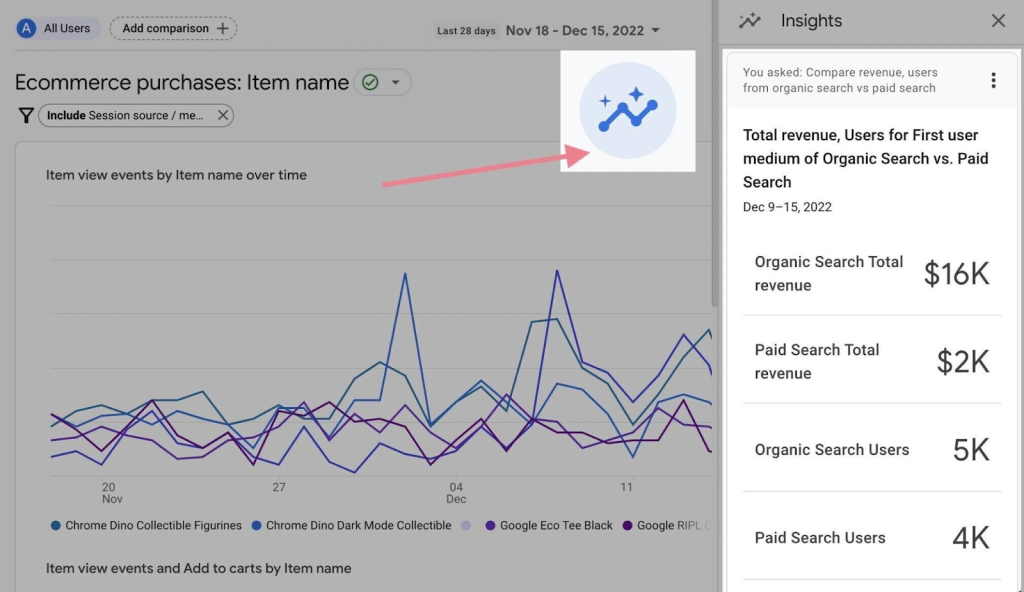
Cost per acquisition (CPA):
CPA in SEO measures the overall cost of acquiring a new customer via organic search. The CPA is the ratio of the total SEO expenses to the number of conversions acquired for the campaign.
Tracking CPA in SEO is quite challenging because you have to define how much it costs to acquire a customer. Plus, you have to consider several unquantifiable factors such as link building, content creation, etc.
How to track:
Use Google Analytics or any other Web analytics tool to set up conversion tracking (using UTM parameters) for your campaigns to monitor which channel is driving conversions.
Bounce rate:
The bounce rate measures the number of visitors leaving your page without action. It is the ratio of the total one-page views to the total visits to your site.
For example, if 1000 users land on your site (the total visits) and 50 leave without performing any action, your bounce rate is 20%.
A high bounce rate doesn’t necessarily mean your SEO campaign isn’t performing well.
According to Google:
How to track:
You can access this data in the ‘Audience Overview report’ on GA:
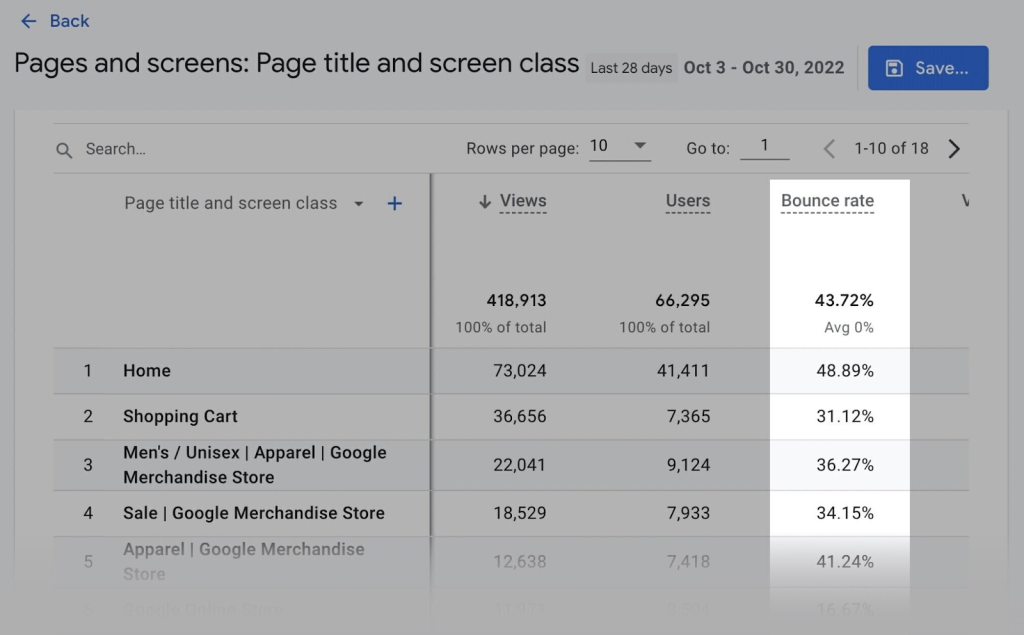
The science of backlink analysis
A good backlink is:
- Authoritative. It should have a high domain authority/rating
- Trustworthy. It should be trusted by users and search engines alike.
- Relevant. The website should be topically related to yours.
SEO tools like Ahrefs and SEMRush have a free backlink analyzer tool that gives a detailed overview of your backlink profile. You’ll see the categories of referring domains and their DA, the anchor texts, the top pages acquiring backlinks, and so on.

With SEMRush backlink analyzer tool, you can benchmark your domain against your competitors and see how you compare:

Ahrefs also provides a detailed analysis:
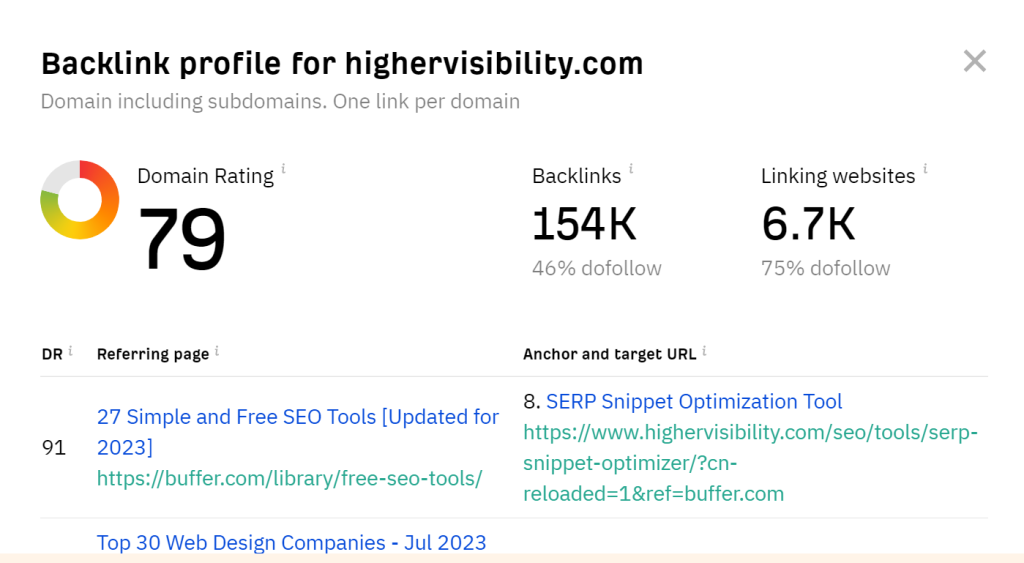
How did you attract high-quality backlinks from sites with high DA?
- Share high-quality, informative articles that extensively cater to user search queries
- Partner with other authoritative and relevant blogs in the marketing industry. This can be through guest blogging, content collaboration, etc. For example, this blog I authored on Search Engine Journal acquired over 300 shares:

- Create engaging visual content and optimize for search engines
- Build a useful tool. Our in-built SEO tools attract some of the highest backlinks to our site:
Gauging User Engagement Metrics
Tracking user engagement on your site is an excellent indicator to how users interact with your website. It provides invaluable insights to the success of your SEO campaigns.
Here are key metrics you should pay attention to:
Average session duration
This is also called the Average Time Spent on Site. It measures the average time users spend on your site, including the activities they engage in each time.
How to track:
Use GA to track the average session duration of your web pages. According to Google, by default, each session lasts up to 30 minutes of inactivity. You can also adjust this timeframe to a few seconds or hours.
Pages per session:
This metric measures the number of unique page visits per session. It is calculated by dividing the total pages visited by the user by the total number of sessions.
How to track:
You can access this metric on GA, too:
High pages per session often correlate with longer dwell time, a positive sign of user engagement. But this metric isn’t valuable in isolation. Sometimes, users can flip through your pages disinterestedly without looking for anything particular. It’s better to analyze it with metrics such as bounce rate and average session duration.
Repeat sessions and brand loyalty
Lastly, you should also examine repeat sessions and the page users constantly return to. This is an excellent indicator of sustained user engagement. Whenever users return to your site, it signifies they have a positive experience while navigating it.
How to track:
On GA, you’ll see in real-time the number of returning users and the exact page attracting their attention. This can help you make informed decisions for optimizing other pages.
The value of Technical SEO metrics
Think of technical SEO as the foundation of your website. It forms the structure of your site and influences the success of other SEO strategies. Optimizing your site for technical SEO creates a better user experience for searchers and helps search engines index your site more effectively.
One of the Google core updates – the core web vitals – hinges on improving the technical aspects of a website. Websites with sturdy technical SEO prove to be more successful than those without.
So, how do you measure technical SEO?
Page speed insights
This measures the total time your web pages take to be visible to users on the internet. Pages with fast load speed often provide a smoother and enjoyable user experience.
How to track:
A quick way to analyze your page speed (on mobile and desktop) is using Google’s own tool, Page Speed Insights:
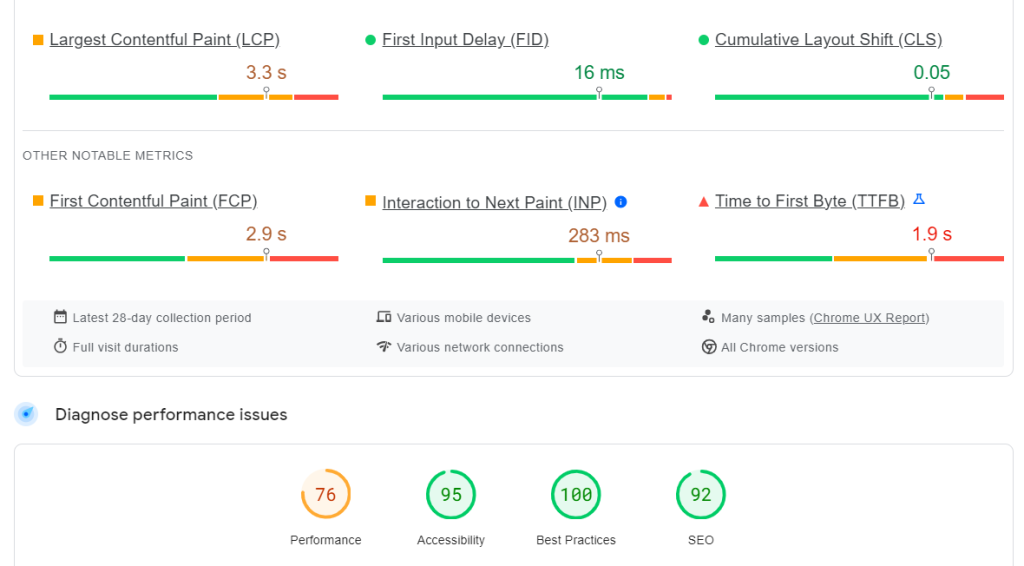
Or GTMetrix:

Mobile Usability
This measures how responsive your website is on mobile devices. Google considers mobile-friendliness as one of its major ranking factors. So, if your site isn’t mobile-friendly, you may experience a hard time increasing your search rankings.
How to track:
A quick way to examine mobile friendliness is using Google’s Mobile-Friendly Test tool:

Crawling Errors
Crawl errors occur when search engine bots try to evaluate your web page content but fail. This can be a result of URL, server, or DNS errors. For example, adding a NOINDEX tag to your web page and submitting it for indexing.
How to track:
Use GSC to check if your website has internal issues. Or use the SEMRush site audit tool to identify the issues affecting your web crawlability:

XML Site Status
Having a well-structured and updated XML sitemap increases your web visibility and crawlability. So ensure your XML sitemaps include all the pages you want your customers to visit when searching on Google.
How to track:
Use the Google Seach Console or SEMRush ‘Site Audit’ tool to check if your sitemaps are updated.
Indexability metrics
Your web pages won’t be visible on the SERPs until it’s indexed by search engine bots. Indexability metrics help you identify issues affecting your site index, such as duplicate content, noindex tags, etc.
How to track:
Use the Google Seach Console or SEMRush ‘Site Audit’ tool to check if your sitemaps are updated.
The role of SEO in content performance
The success of your content marketing strategy in SEO is measured by how much value (either in revenue or other forms of conversion) it brings to your business.
It’s only ideal that you evaluate how well your content is performing to identify opportunities for growth and strategies you can replicate for future campaigns.
- Examine your best-performing content pages. What form of content is it? Does it have more visuals? How is the CTA structured? What is the primary traffic source? This analysis will help you replicate what’s working and fix what isn’t.
- Also, analyze the user engagement on each page to draw out key factors influencing the rankings. Visit the ‘User Engagement’ section in this piece to know what metrics to track.
- Use SEO tools like SEMrush to identify gaps in your content strategy. These tools also provide comprehensive insights into your competitor profile to see your performance and identify gaps you can leverage.
- If you notice pages that used to perform well but have fallen off, consider re-updating the content to an evergreen piece. Check out for outdated stats and citations, and if the stats are recent, ensure the outbound link is still active.
Integrating Analytics Platforms
To be candid, you can’t effectively measure or keep track of your SEO efforts without the right tools. Luckily, you’ll find myriad cutting-edge analytics tools, including free and paid, that provide real-time insights into your SEO campaigns.
I recommend starting with Google’s tools, especially if your primary search engine is Google. All the Google Analytics tool tools are free. Here are the top five we use for our clients at HigherVisibility:
- Google search console: For tracking metrics relating to search traffic.
- Google Analytics: We combine this with GSC to generate even richer data on search traffic
- Google PageSpeed Insights: To analyze core web vitals and the issues impacting page speed
- Google Mobile-Friendly Test: To evaluate website mobile-friendliness
- Google keyword planner: For discovering high-conversion keywords
There are also many excellent third-party SEO tools that you can use to generate additional insightful data for your SEO efforts and that of your competitors, too!
These tools also help identify technical and on-page optimization issues and provide insights on mitigating or solving them. Common examples are:
- SEMRush: Best for site audit and competitor analysis
- Ahrefs: Best for advanced content and overall site audit
- Screaming Frog: Best for analyzing technical SEO
- HigherVisibility SERP Optimizer Tool: Best for predicting how your web page looks on the SERPs
- Keyworddit: Best for extracting keywords from subreddit
- Bulk Keyword Generator: Best for generating local keywords
Read more on the top free SEO tools for auditing and monitoring your website.
Measuring SEO success is crucial, but getting it right takes expertise. Partner with us to track the right metrics and ensure your strategy delivers results. Request a tailored proposal today and start seeing success with our proven approach.

Wrapping it up…
If you’ve not started tracking and measuring your SEO efforts, you’re missing out on relevant, real-time data that can transform your entire digital experience. Plus, it’s the only true way to know the outcome of your SEO efforts and how it applies to your overall marketing goals. If you need an SEO professional to show you how to track your SEO performance effectively, schedule a free call now with any of our experts.
